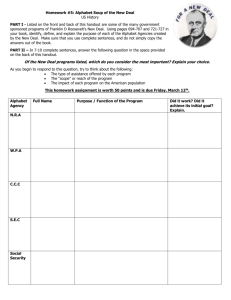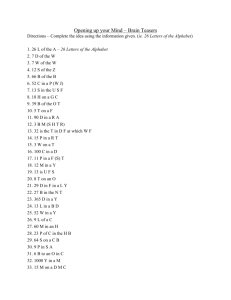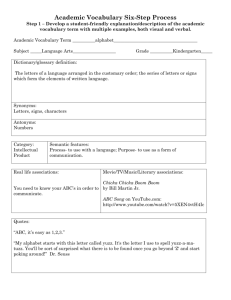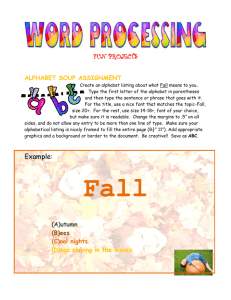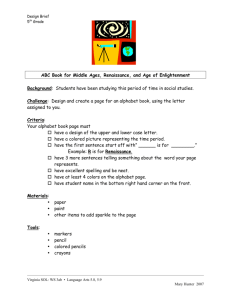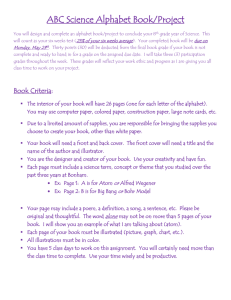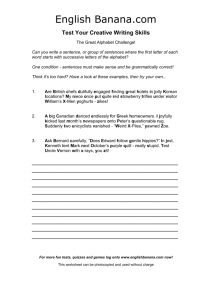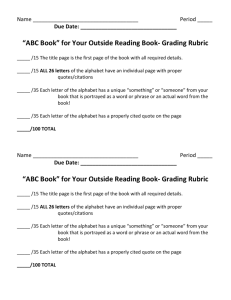• f? Arfi!
advertisement
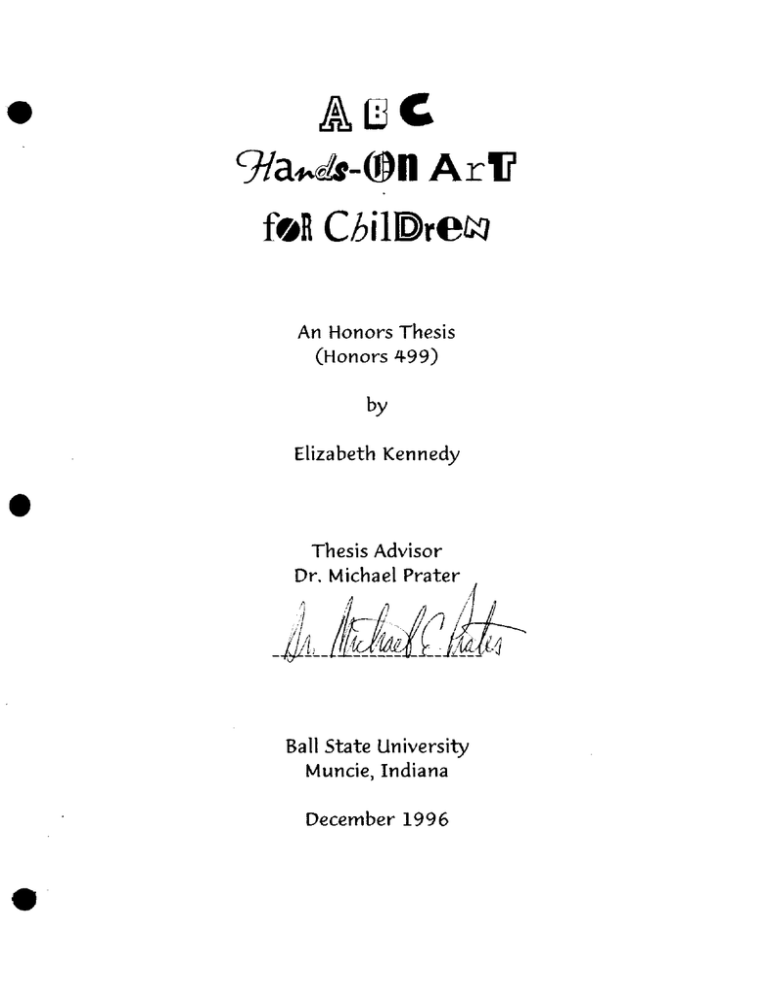
•
~D~
9fa~~-QI)n
foR
Arfi!
Chil~re~
An Honors Thesis
(Honors 499)
by
Elizabeth Kennedy
•
Thesis Advisor
Dr. Michael Prater
~'~'
/11
A7&··~
:--h) f? /) /' .
1/It.Jd1& '( ~ 11di/
-./.dL-~- ------ r:.._l,-__· './
}
Ball State University
Muncie, Indiana
December 1996
•
•
~oC
91a~d.t-®n
Arti
fon Ch ilID>reC:!J
•
This project is a children's ABC art book in which each page is
devoted to one letter of the alphabet. On each page an artist or
artwork; period or style of art; and an element, technique, or principle
of art is discussed -- each beginning with the same letter of the
alphabet. The ABC format provides a common theme that is familiar
to children and is easy to follow. It also allows children to flip through
the book in a non-linear manner, instead of reading page by page. An
interactive aspect in which children physically manipulate the book
(pop-up or fold-out mechanisms, for example) is also incorporated for
each letter in order to actively engage the reader. Because some of the
vocabulary and ideas presented may be rather advanced, the book's
targeted audience is upper elementary students (grades 3-6).
Educational Objectives:
•
1.
To stimulate an interest in art through visual and
tactile interaction
2.
To provide an abridged introduction to art
3.
To build an art vocabulary through a familiar
ABC format
4.
To develop an allusionary base
5.
To serve as a quick reference tool
Ansel Adams was an
American photographer
known for his landscape
(forests, rivers, and
mountains) photographs of
the Western United States
during the 20th century.
He strongly believed that
photographs should be
simple, detailed, and
focused on the objects
being photographed.
Ah"tr.lic't E\prcs~i(lnisll1
Thi~ ,t~'le
of painting
began in the cady
1940's and ended in the
1961h, Abstract
Expressionists belieYcd
that thc process 01
painting was just as
important (if not mol','
so) than th£' prodwct.
These nainter, no
lougel' fl1110" cd tht'
traditional technique of
Lrcatin~ n~cn~(' il.:' f Jk
ubj('ct...:: ;qql;'''h i . r!!~'~.'
spla.'ll,cd p~lint 'In
C~Hl"':h'lC~
:..ind
shap.·
t1.r>.
'lEd
I,'! i1
::-H.f
.
'
. -
F
ASYMAfETRY
.:\symmetry is a rrinciple ofar1 that shows unid~lltical :;idc~
in d C(lI1lPOSilioli. fold over ,ill' ria"tic uflhc 1011 pictUIL'
and see ho\\ 1!1~ sh<lpes 1ll:11cil up. Ihi~ is cCllled S)!lU11.l;'tl).
Now :(1U PVCI' the pla~tic Ull the butlol11 picture.I!K Sh'II'L'~
do nul 1.I,ltch l!P because the pictLIt'c is ,1:»),1])11LdllCJl
•
-----~
... -.
,,
•
,
"\'
",
"'-
•
£,
:onomy is the technique of using as few
colors, and shapes as possible while still
:;ating art that can be easily recognized.
panese artists excel at using this technique.
ltice in the pictures above and to the right
Jt there is little detail or color. Even so,
ages of horses, trees, and a house are
,ticeable.
3S,
•
M.C. Escher
'NOS'::;
Jutcr :::l!"-,iS~
::;-F" tne 2C)if": :::enTur", >-ie ,:: .... eoied art'vvor-k.
tt-·ot comolned ?erspeCT've .:Jnc! opiicc:
liusior"\
ThC-r
seemed
-'-0 .... .-·C<:::
the
~!nd.
;:::or example, In t-he Dicrure Ie the for ief+-.
the drc'vving har'njs appear-
~o
come cui
of the poper ;::mc drc\A, .... hemseives. We
know t h cr7"
+'115
ar"t' VlsuOiiv
can no"" t"1oopen. ':Jut the
snows Tha+ ;-r-
CO('"1.
Escher
also c:-eorec visual ;Juzzles 'n w~;ch or
objeciis '-eos-oied "'0 +o:-:-r: a potter'! "!"r.at
con seer-ring!Y :::ontinue or .;ors-ve,.... Notice
how t~e "-ec, yellow, and greer :iz:crds
(left) +; ....
-ogei~,e:- pe.-fect"!"y
T ne zipper
bag :::n t'"""'e T"ght- cant-airs :::,--,zzle pieces
:ho .... :..:c r :JE' .:J,_ . . ";"oge-r~e:- -:;: '110ke on
Escne- ]
"'\,vQ~"- .
It
:Jd:fc-,it tnar :- a.ppears
,S
'""1(:
--S
..,-.-.",.
t-o ;:;,.... T
orne(¥!
Egyptltu£ Art
together.
is especially valued because it is so old and rare. Because
Egyptians believed in life after death, they buried their rulers with many jewels
and riches. The gold burial mask of King Tut (above, left) is a good example of
this Egyptian practice. The image of Queen Nefertiti (above, right) shows how
Egyptian sculpture became less stiff and more life-like through the centuries.
•
G
B
•
•
GRIDS
-
-.
-
4'
'"
-.
i~
~::. .
-¥:7'--' .'-
Grids are useful
drawing tools.
By laying a grid
over a pIcture,
an artist can
visuallv diVide
the picture into
squares. The
image can then
be easily drawn
section by
section.
"
The Gothic style
flourished during
the 12th through
the 16th centuries
in Europe, mostly
England and France.
Chartres Cathedral
(above) is a wonderful
example of Gothic
architecture because
it shows rose (stained
01'"(:;_1--'/
ce·\
.6
uri
n ..-1 "ViS
VV.1 .... "-u . . ,·
" ~
elt.n ,gUl+-e'-i
U
1
-
--.
-
......
<-·....,~-.~l·n'i-il .. 'f~.
~\...U j-.l"'~,
-. .
"
~ .·~·r
~"
,..
•
Lithography
lS
a pnntlllg
1'1'0(''''" 111
wIuch a design is drawn on a nat stone block
with a gI'pasp crayon. Ink
and
~h{),vs
lS
applipd
only thp ungrp3sed
arp;1.S
to thi' .c,::,IODP
of th(, design.
Kathe Kollwit" proriucerilithography prints
dUring- the early 20th century. "lost of her work
depicts jhe ,sutfE'ring Hnd unrest shp witnes!':'ed
ill German\,. ''Pi eta
[II."
(right) which means
"pit v," was printpd in 1903.
•
•
Jeonardo da Vinci worked during the High ltahan Renaissance (J50() - l:;~O AD). One of hi;, most ["II
,,,intings is "The Last Supper," ahove. Noliee how all th" diagonalllllcs in the ceiiing and on I.he waUs COllie
ogother at Christ's head in the centPf of the composition; hence, liP '" Hw focal poillt of the painting, The apost
~CPS and hand gestures point in Christ's direction, and the windows on the far 'vall provide a light/dark contra,
hat further highlight Christ.
L I
A line
j"
~
E
simply the path left by a moving point.
Lines can b,' duck. trun. curvy. straigh:. vertical.
horizontaL
·If
diagonal. There are two kind of lines:
Implied Lines
broken lines
Actual Lines
unbroken lines
S:ud\- <-The Las: Supper" (belo\\'. l(;;;i't). How many
Impb·:<i a.nd acruallines can you find?
The Mona Lisa
This is Leonardo's
most famolls painting.
He perf~ct.ed s[umaJQ.
the Jay(>ring of glaze
paints when he painted
this wife of an ltalian
merchant.. Hpr steady
gaze. hint of a smile.
and hand positions
make her "pry
realistic all d life-like.
•
:;$> :-
Po
app
so
I
visL
sha
is n
the
Sel
pair
Aft
La
will
tho
of ~
•
•
Perspective
is a technique
of creating the illusion of
three-dImensional space on a
two-dllnensional surface like a
canvas or wall. Tn the piclnre
to the right. notice how both the
tops and bases of tbe trees seem
to follow a line that eventually
disappears in the distance at the
horizon line. Also notice tbat
the trees are smaller in the
backh'TOlmd than they are
in the foreground. These two
principles of implied lines and
diminishing shapes are
important aspects of linear
Pointillism
is a method of
applying "points" of pure color
so closely that the human eye
visually mixes the colors into
shapes and forms. This style
is most often associated with
the French painter Georges
Seurat. Look closely at the
painting to +he left, "Sundey
Afternoon on The Is/ono of
La Grande Jette." and you
will seeche inc;vicuo' speC'~s
the1- blend to meke +he +0"-'1'<3
of peopie. t, ecs, one' o:-<r-r-:cis_
j
}
--.z
t
,
/ / \.
P;ca~~o wag OtH! of the mog
influential attigtg of the 20t
centuty. /-Ie cteated many
paintingg, gculptuteg, and
Iithogtaphg. Notice in the
pictuteg to the left and above
that the women~g bodieg ate
btoken into ghapeg like puzzlf
pieceg and then put back
togethet. Thig gtyle of paintit
Cubigm, Wag developed by
Picaggo and Geotgeg Btaque.
Cubigtg al.!:o hied to paint all
!!ide;: of fhtee-dimen.!:ional
ob[ectl! On i'l flat C1HWal!.
•
Educational Theo!)' Base for
ABC Hands-On Art
for Children
Elizabeth Kennedy
This book was designed and written to fulfill an honors elementary
education undergraduate thesis requirement. A strong interest in art and a love for
writing children's books prompted this project topic. Clear objectives supported
by educational theo!)' make this book a solid educational tool and valuable
resource for parents and teachers of upper elementary school children.
This book was designed to stimulate an interest in art through visual and
tactile interaction with text and pictures. It is commonly believed that children
learn best by doing. Piaget states that children proceed through developmental
•
stages. The children for whom this book is intended (ages 7-1 I) are at the
concrete-operational stage, meaning they need to be physically engaged in their
learning. In accordance with this theo!)', each page ofthe book involves some sort
of manipulative device that gives children hands-on opportunities to explore art.
Examples of such interactives are felt boards and shapes on the "B" and "0"
pages, transparency lift-ups on the "P," "R," and "X" pages, and the art production
areas on the "J" and "Q" pages. These activities encourage children to touch and
do; they entice the reader to learn.
This book was also designed to provide an abridged introduction to art. For
each letter of the alphabet (X and Z excepted), an artist or artwork; art style or
period; and a technique, element, or principle of art is shown. Each of these three
topics begins with the same letter of the alphabet, depending upon the page. The
letter of the alphabet provides an organizational framework that is visually
•
•
•
repeated throughout the page. For example, on the "A" page three A's span the
background of the page. Ansel Adams, Abstract Expressionism, and AsymmetIy
provide text content and visuals. The transparency flips demonstrate asymmetIy,
fulfilling the interactive aspect of the book. In addition, a small A is placed left of
the gutter (center), thus completing the letter organization of the page. The page is
also visually organized by primary colors and asymmetrical balance, and each
picture and text block is matted on black paper to provide continuity and
coherence within the page.
Piaget's learning theories also support the letter and visual organizers on
each page. Schema theory states that humans are born with the tendency to
organize infOimation through a kind of internal file folder system called schemata.
The familiar pattern of the alphabet, firmly established in the targeted readers'
minds, is the primary schema for each page. The alphabet sets up an immediate
structure even before any text is read; readers know that the art ideas on the page
will all begin with the same letter. This helps to keep the unfamiliar art concepts
neatly ordered and arranged so that learning can occur.
Another objective of the book is to develop the allusionary base of the
reader. Because this book is filled with over 100 pictures of famous artworks, the
reader is visually bombarded; however, the reader is not overwhelmed because
each page is organized by the predictable alphabet. The purpose, then, for the
visual bombardment is to immerse the reader in famous artwork so that these
images become more and more familiar. It is the ultimate intention for the reader
to encounter one of the artworks at a later date and be able to identifY it, or at least
show some form of recognition or understanding.
The final objective is to serve as a quick reference tool in the classroom or
at home. This book is not a complete art reference by any means, but careful
selection of artists, artworks, styles, elements, principles, and techniques was
•
made. Again, the alphabet provides a familiar organizer. Children are accustomed
to looking up concepts in dictionaIies and encyclopedias where the alphabet is also
the primary organizer. [n the same way children have access to English
vocabulary and various topics of interest, this book provides a familiarly organized
opportunity with art and hands-on art exploration.
This book is unique in its design and intention. Few children's art books
are alphabetically organized, and an art book with an interactive element for every
page has yet to be seen. The objectives of the book are created from an art
educator's standpoint: to stimulate interest in art through hands-on interaction, to
provide an abridged art introduction, to develop an allusionary base, and to serve
as a quick reference tool. Because this book can be backed by educational theory,
it is a valuable educational tool for children and adults alike .
•
Bibliography
Joyce, B et aI. Models of teaching. Boston: Allyn and Bacon.
Woolfolk, A.E. (1993). Educational psychology
Allyn and Bacon.
Boston:


